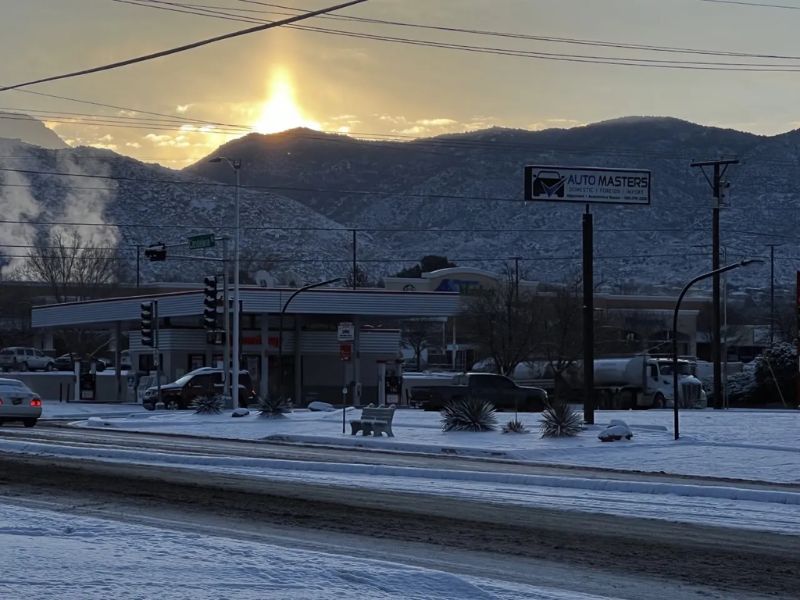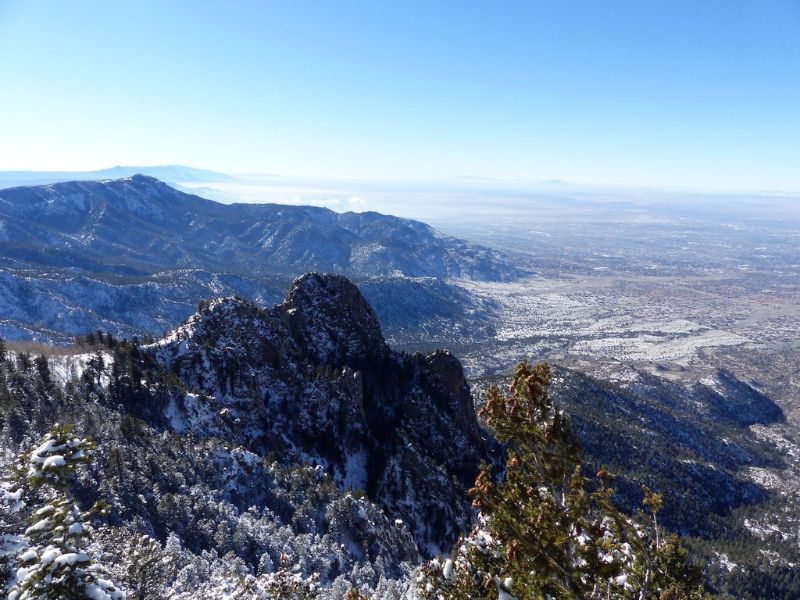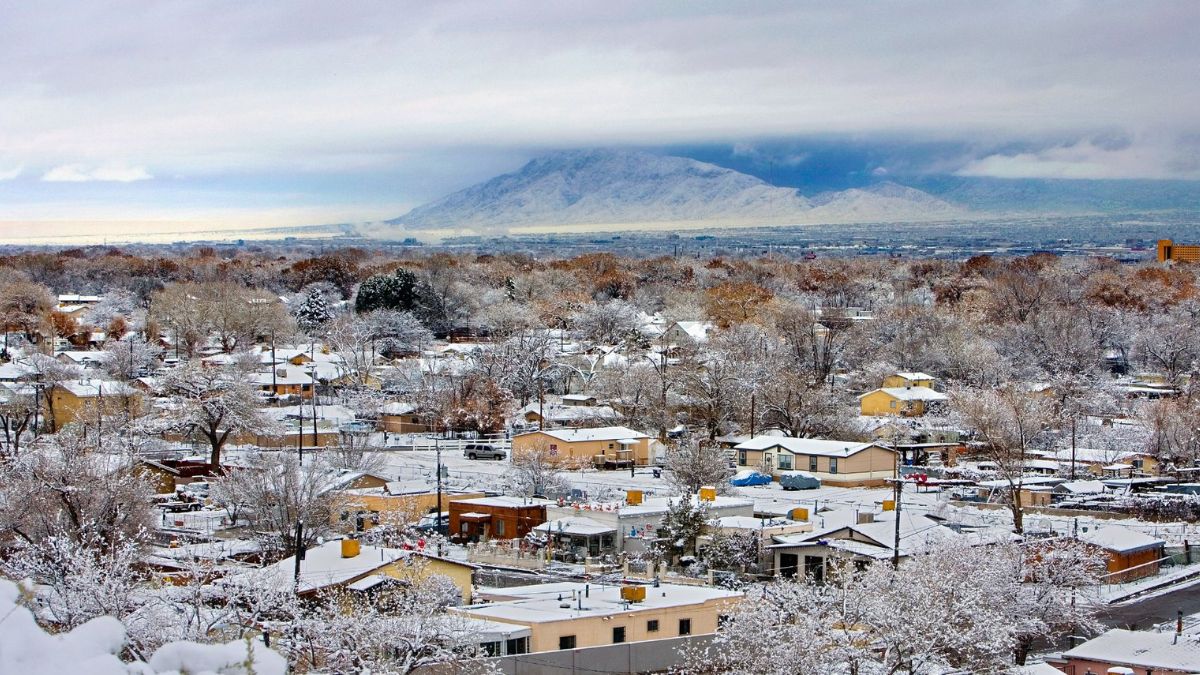Yes, it does snow in Albuquerque, New Mexico. Despite its desert-like reputation, Albuquerque experiences some snowfall during the winter months. The city’s location in the high desert at an elevation of around 5,000 feet above sea level contributes to occasional snow events.
On average, Albuquerque receives about six to eight snowy days per year. The snowfall is often light and may accumulate to a few inches, but heavier snowstorms can occur periodically. The winter season in Albuquerque typically spans from November to March, with the highest likelihood of snowfall occurring between December and February.
While the snowfall in Albuquerque may not be as frequent or heavy as in northern states or mountainous regions, it still provides residents and visitors with opportunities to enjoy winter activities and witness picturesque scenes, especially against the backdrop of the nearby Sandia Mountains.
Albuquerque, New Mexico, with its warm climate and sunny days, may not be the first place that comes to mind when thinking about snow. However, snowfall is a reality in this vibrant Southwestern city despite its desert-like reputation.
In this article, we will explore the climate of Albuquerque, the frequency and intensity of snowfall, and how the city embraces the winter season.
Location Overview of Albuquerque
Nestled in the heart of the American Southwest, Albuquerque is a vibrant city with a rich history, diverse culture, and stunning natural landscapes. As the largest city in New Mexico, Albuquerque boasts a unique blend of modern urban amenities and the charm of its Spanish and Native American heritage.
Albuquerque is situated in the central part of New Mexico, within the southwestern United States. The city is located in the upper Rio Grande Valley, surrounded by majestic mountain ranges and high desert terrain.
The city’s elevation is a notable characteristic of its location. Albuquerque sits at an elevation of around 5,000 feet above sea level. The higher elevation contributes to the city’s unique climate and diverse landscapes.
To the east of Albuquerque, the towering Sandia Mountains rise dramatically, providing a picturesque backdrop for the city. These mountains are known for their striking red hues during sunrise and sunset, earning them the nickname “Sandia” (Spanish for “watermelon”).
On the west side of Albuquerque, the Petroglyph National Monument features ancient volcanic escarpments adorned with petroglyphs, offering a glimpse into the area’s prehistoric past.
Albuquerque’s location in the high desert of New Mexico, surrounded by majestic mountains and the Rio Grande River, contributes to its unique climate and breathtaking scenery. Its rich cultural heritage, modern urban amenities, and proximity to nature make it a compelling and inviting destination for both residents and visitors alike.
Whether you are interested in history, culture, outdoor activities, or simply enjoying the stunning vistas, Albuquerque has something to offer everyone.
Geography and Climate of Albuquerque
Albuquerque is located in the high desert of New Mexico, surrounded by the Sandia and Manzano mountain ranges. The city enjoys a semi-arid climate with hot summers and mild winters. Due to its elevation above sea level, Albuquerque experiences significant temperature fluctuations between day and night, regardless of the season.

Albuquerque experiences a semi-arid climate with four distinct seasons. Summers are hot and dry, with average temperatures in the high 80s to low 90s Fahrenheit. Winters are generally mild, with daytime temperatures ranging from the mid-40s to low 50s Fahrenheit and nighttime temperatures dropping significantly due to the high elevation.
Historical Snowfall Record of Albuquerque
Albuquerque’s historical snowfall record showcases occasional but memorable snow events that have left a lasting impact on the city. While snowfall in Albuquerque is generally infrequent, several notable snow events have occurred over the years:
- Christmas Eve Snowstorm (1987)
One of the most significant snow events in Albuquerque’s history occurred on Christmas Eve in 1987. A powerful winter storm brought heavy snowfall to the city, resulting in a winter wonderland scene on Christmas morning. Snow accumulations reached around 12 inches in some areas, causing widespread excitement and delight among residents.
- Super Bowl Snowstorm (1993)
The city experienced another memorable snow event during the 1993 Super Bowl Sunday. A snowstorm struck on January 31, 1993, blanketing the region with up to 8 inches of snow. This rare occurrence during the Super Bowl game added a unique touch to the city’s celebration of the sports event.
- Thanksgiving Snowstorm (2006)
Albuquerque had a memorable Thanksgiving Day in 2006 when a winter storm surprised the city with several inches of snowfall. This unexpected snowfall added an extra layer of holiday charm to Thanksgiving celebrations and festivities.
- Valentine’s Day Snowstorm (2019)
On Valentine’s Day in 2019, a winter storm brought snow to Albuquerque, creating a picturesque backdrop for the romantic holiday. While not an exceptionally heavy snowfall event, it was still noteworthy due to its timing on a day of celebration.
While these snow events are not as frequent as in colder regions, they serve as a reminder of the city’s unique climate and the occasional touch of winter magic it experiences.
Winter Season & Snowfall Pattern of Albuquerque
While Albuquerque is known for its dry weather, snowfall is not an uncommon occurrence during the winter months. The winter season typically spans from November to March. The arrival of snow is influenced by weather patterns and occasional storms that bring moisture to the region.

Albuquerque snowfall is less frequent than in northern states or mountainous regions. However, residents can expect to see snow several times throughout the winter. On average, Albuquerque experiences approximately six to eight snowy days per year.
The snowfall is often light and accumulates to a few inches, but heavier snowstorms can occur periodically. When snow does fall in Albuquerque, it can create picturesque scenes, especially against the backdrop of the Sandia Mountains.
While the snowfall may not be as heavy as in some other parts of the country, it still adds a charming touch of winter magic to the city. The temperature during snow events tends to hover near or slightly above freezing, so the snow may melt quickly in the following days.
Locations to Enjoy Snow in Albuquerque
Despite its reputation for warm and sunny weather, Albuquerque, New Mexico, does offer opportunities to enjoy snow during the winter season. While the snowfall may not be as frequent or heavy as in some other destinations, there are a few locations in and around Albuquerque where you can experience the magic of snow.
Here are some places to enjoy snow in Albuquerque:
- Sandia Peak Ski Area
Located just a short drive from Albuquerque, the Sandia Peak Ski Area offers an excellent winter playground for snow enthusiasts. The ski area sits atop the Sandia Mountains and provides stunning panoramic views of the city and surrounding landscapes.
It features ski slopes suitable for all skill levels, from beginners to advanced skiers and snowboarders. Whether you are looking to hit the slopes or simply enjoy the winter wonderland, Sandia Peak is a must-visit destination.
- Sandia Crest
If you prefer a more laid-back snow experience, a visit to the Sandia Crest is a great option. You can drive up to the crest, which is the highest point of the Sandia Mountains accessible by car, and enjoy the snow-covered scenery.
There are several viewing areas and hiking trails where you can take in the breathtaking views and capture memorable photos of the snow-capped landscape.
- Petroglyph National Monument
While not primarily known for snow activities, the Petroglyph National Monument can be a unique place to witness snowfall amidst ancient volcanic rocks adorned with petroglyphs. The contrast of the snow against the dark volcanic rocks creates a striking visual appeal and offers a different perspective on the monument’s historical significance.
- Open Spaces and Parks
When Albuquerque experiences snowfall, the city’s parks and open spaces transform into ideal spots for snowball fights, sledding, and building snowmen. Many local parks, such as Balloon Fiesta Park and Los Altos Park, become popular destinations for families and friends seeking winter fun in the snow.
- Rio Grande Nature Center State Park
This nature park is a serene spot where you can appreciate the beauty of snow in a more natural setting. The park features walking trails along the Rio Grande River, offering an opportunity to observe winter wildlife and enjoy the peaceful ambiance of the snowy surroundings.
- Santa Fe (Day Trip)
Although not within Albuquerque itself, a short drive to Santa Fe, the capital of New Mexico, during the winter season can be a delightful snow-filled adventure. Santa Fe often experiences more snowfall than Albuquerque due to its higher elevation, and its historic architecture and charming atmosphere add to the winter experience.
Whether you are a seasoned winter enthusiast or just looking to experience a touch of snow during your visit, Albuquerque and its surrounding areas offer an array of options to make the most of the winter season.
Factors Influencing Snowfall in Albuquerque
Snowfall in Albuquerque is influenced by several factors. The city’s semi-arid climate plays a significant role, as it typically experiences dry and sunny weather. However, occasional winter storms originating from the Pacific or Gulf of Mexico can bring moisture to the region, leading to snowfall.
The city’s higher elevation of around 5,000 feet above sea level also contributes to snowfall occurrences, as colder temperatures at this altitude allow precipitation to fall as snow instead of rain.
The nearby Sandia Mountains can further enhance snowfall, as they act as a barrier, causing precipitation to be more concentrated on the eastern side of the city, where the mountains are situated.
While snow events are relatively infrequent compared to northern states, these factors combine to create opportunities for residents and visitors to enjoy the beauty of snow in Albuquerque during the winter months.
Conclusion
While Albuquerque, New Mexico, may not be known for its snowy winters, it does experience some snowfall each year, adding a touch of winter beauty to the desert landscape. The infrequent snow events allow us to indulge in winter activities and enjoy the picturesque scenery against the majestic backdrop of the Sandia Mountains.
So, the next time you plan a trip to Albuquerque during the winter season, don’t forget to check the weather forecast and be prepared for possible snowfall during your stay!
